Operations and Project Management Report - Unilever Case Study
VerifiedAdded on 2023/01/12
|13
|4359
|53
Report
AI Summary
This report examines operations and project management principles through a detailed analysis of Unilever and Portakabin. The report begins with an introduction to operations management, emphasizing its significance for organizational success. It then reviews the implementation of operations management principles at Unilever, a multinational company, highlighting key aspects such as reality, organization, fundamental principles, accountability, variance, and causality. The report also includes a critique of operations management principles and designs a continuous improvement plan, exploring concepts like Lean principles and Six Sigma methodologies. Furthermore, the report delves into project management, producing a project life cycle and documentation for Portakabin, a company specializing in modular buildings. Finally, it critiques the effectiveness of the project life cycle using different theories and concepts, providing recommendations for improvement. The report aims to provide a comprehensive understanding of operations and project management practices, using real-world examples to illustrate key concepts and strategies.
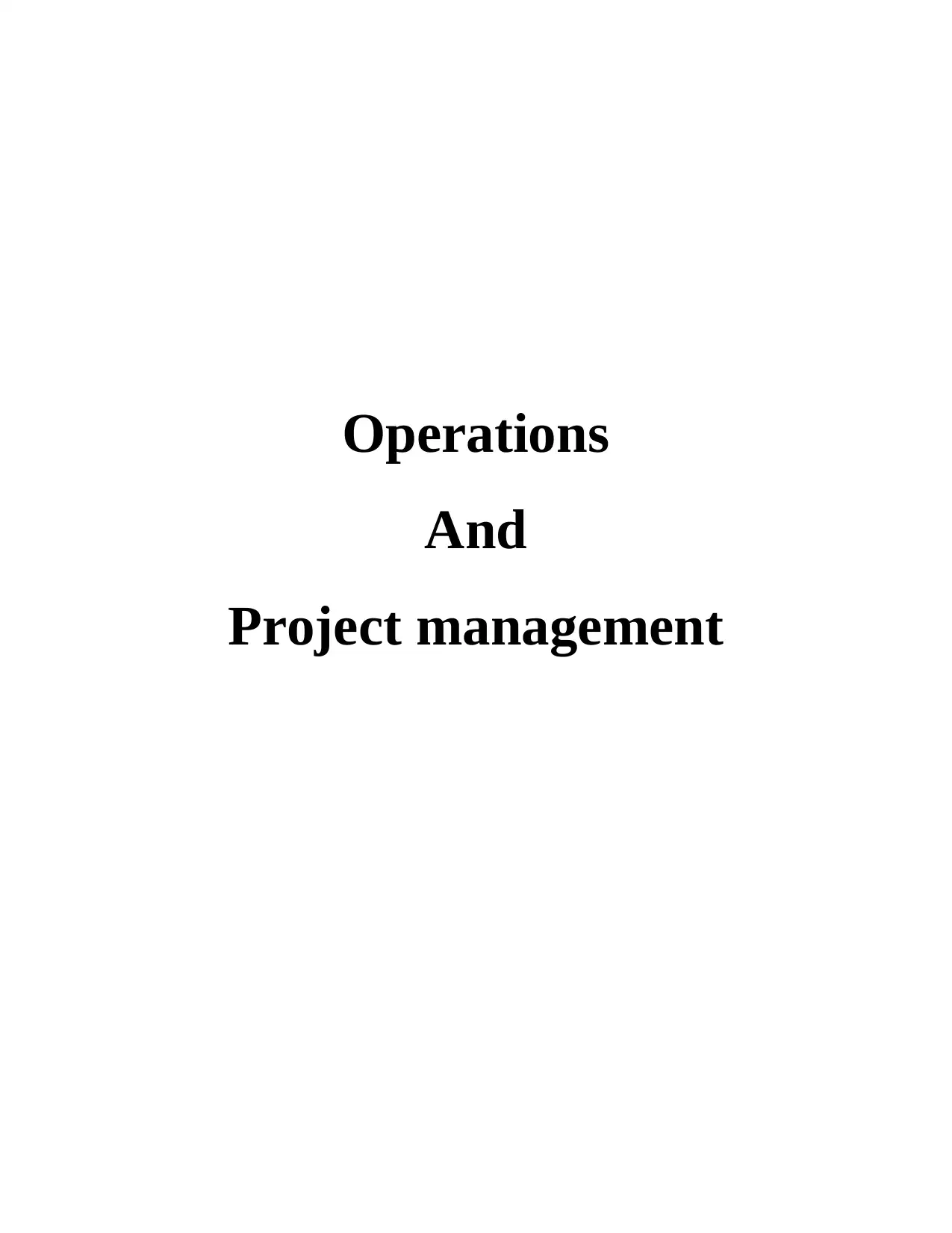
Operations
And
Project management
And
Project management
Paraphrase This Document
Need a fresh take? Get an instant paraphrase of this document with our AI Paraphraser
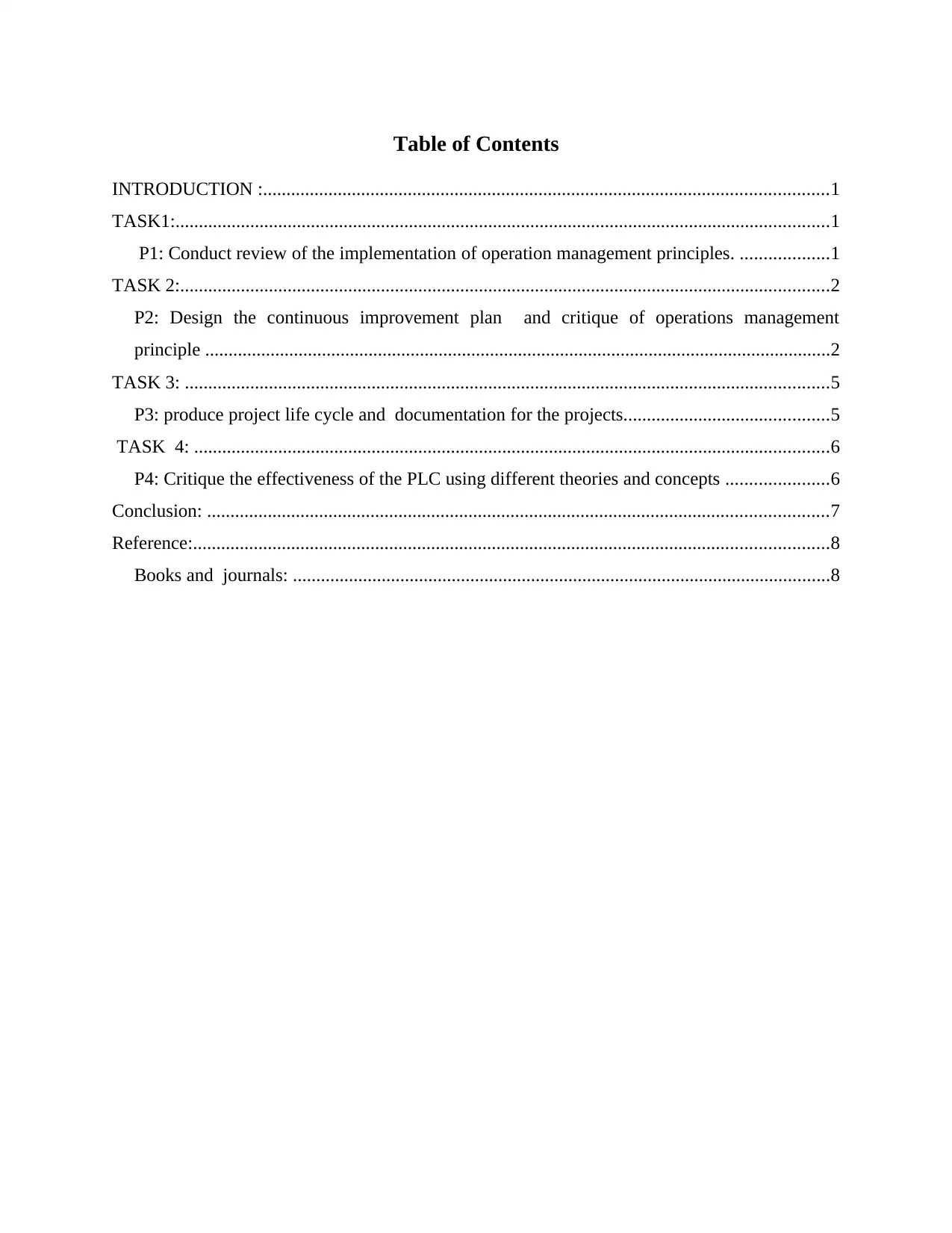
Table of Contents
INTRODUCTION :.........................................................................................................................1
TASK1:............................................................................................................................................1
P1: Conduct review of the implementation of operation management principles. ...................1
TASK 2:...........................................................................................................................................2
P2: Design the continuous improvement plan and critique of operations management
principle ......................................................................................................................................2
TASK 3: ..........................................................................................................................................5
P3: produce project life cycle and documentation for the projects............................................5
TASK 4: ........................................................................................................................................6
P4: Critique the effectiveness of the PLC using different theories and concepts ......................6
Conclusion: .....................................................................................................................................7
Reference:........................................................................................................................................8
Books and journals: ...................................................................................................................8
INTRODUCTION :.........................................................................................................................1
TASK1:............................................................................................................................................1
P1: Conduct review of the implementation of operation management principles. ...................1
TASK 2:...........................................................................................................................................2
P2: Design the continuous improvement plan and critique of operations management
principle ......................................................................................................................................2
TASK 3: ..........................................................................................................................................5
P3: produce project life cycle and documentation for the projects............................................5
TASK 4: ........................................................................................................................................6
P4: Critique the effectiveness of the PLC using different theories and concepts ......................6
Conclusion: .....................................................................................................................................7
Reference:........................................................................................................................................8
Books and journals: ...................................................................................................................8
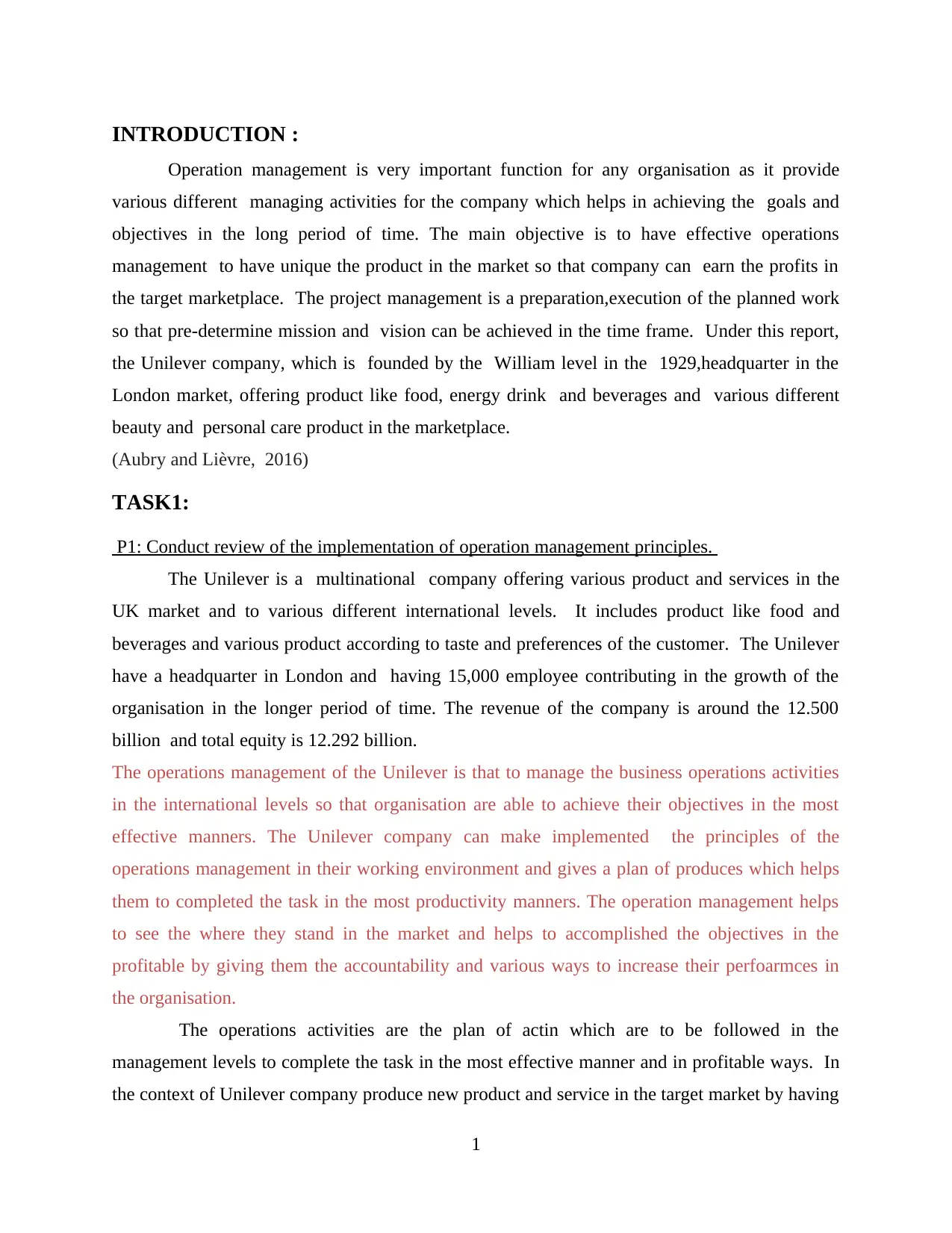
INTRODUCTION :
Operation management is very important function for any organisation as it provide
various different managing activities for the company which helps in achieving the goals and
objectives in the long period of time. The main objective is to have effective operations
management to have unique the product in the market so that company can earn the profits in
the target marketplace. The project management is a preparation,execution of the planned work
so that pre-determine mission and vision can be achieved in the time frame. Under this report,
the Unilever company, which is founded by the William level in the 1929,headquarter in the
London market, offering product like food, energy drink and beverages and various different
beauty and personal care product in the marketplace.
(Aubry and Lièvre, 2016)
TASK1:
P1: Conduct review of the implementation of operation management principles.
The Unilever is a multinational company offering various product and services in the
UK market and to various different international levels. It includes product like food and
beverages and various product according to taste and preferences of the customer. The Unilever
have a headquarter in London and having 15,000 employee contributing in the growth of the
organisation in the longer period of time. The revenue of the company is around the 12.500
billion and total equity is 12.292 billion.
The operations management of the Unilever is that to manage the business operations activities
in the international levels so that organisation are able to achieve their objectives in the most
effective manners. The Unilever company can make implemented the principles of the
operations management in their working environment and gives a plan of produces which helps
them to completed the task in the most productivity manners. The operation management helps
to see the where they stand in the market and helps to accomplished the objectives in the
profitable by giving them the accountability and various ways to increase their perfoarmces in
the organisation.
The operations activities are the plan of actin which are to be followed in the
management levels to complete the task in the most effective manner and in profitable ways. In
the context of Unilever company produce new product and service in the target market by having
1
Operation management is very important function for any organisation as it provide
various different managing activities for the company which helps in achieving the goals and
objectives in the long period of time. The main objective is to have effective operations
management to have unique the product in the market so that company can earn the profits in
the target marketplace. The project management is a preparation,execution of the planned work
so that pre-determine mission and vision can be achieved in the time frame. Under this report,
the Unilever company, which is founded by the William level in the 1929,headquarter in the
London market, offering product like food, energy drink and beverages and various different
beauty and personal care product in the marketplace.
(Aubry and Lièvre, 2016)
TASK1:
P1: Conduct review of the implementation of operation management principles.
The Unilever is a multinational company offering various product and services in the
UK market and to various different international levels. It includes product like food and
beverages and various product according to taste and preferences of the customer. The Unilever
have a headquarter in London and having 15,000 employee contributing in the growth of the
organisation in the longer period of time. The revenue of the company is around the 12.500
billion and total equity is 12.292 billion.
The operations management of the Unilever is that to manage the business operations activities
in the international levels so that organisation are able to achieve their objectives in the most
effective manners. The Unilever company can make implemented the principles of the
operations management in their working environment and gives a plan of produces which helps
them to completed the task in the most productivity manners. The operation management helps
to see the where they stand in the market and helps to accomplished the objectives in the
profitable by giving them the accountability and various ways to increase their perfoarmces in
the organisation.
The operations activities are the plan of actin which are to be followed in the
management levels to complete the task in the most effective manner and in profitable ways. In
the context of Unilever company produce new product and service in the target market by having
1
⊘ This is a preview!⊘
Do you want full access?
Subscribe today to unlock all pages.

Trusted by 1+ million students worldwide
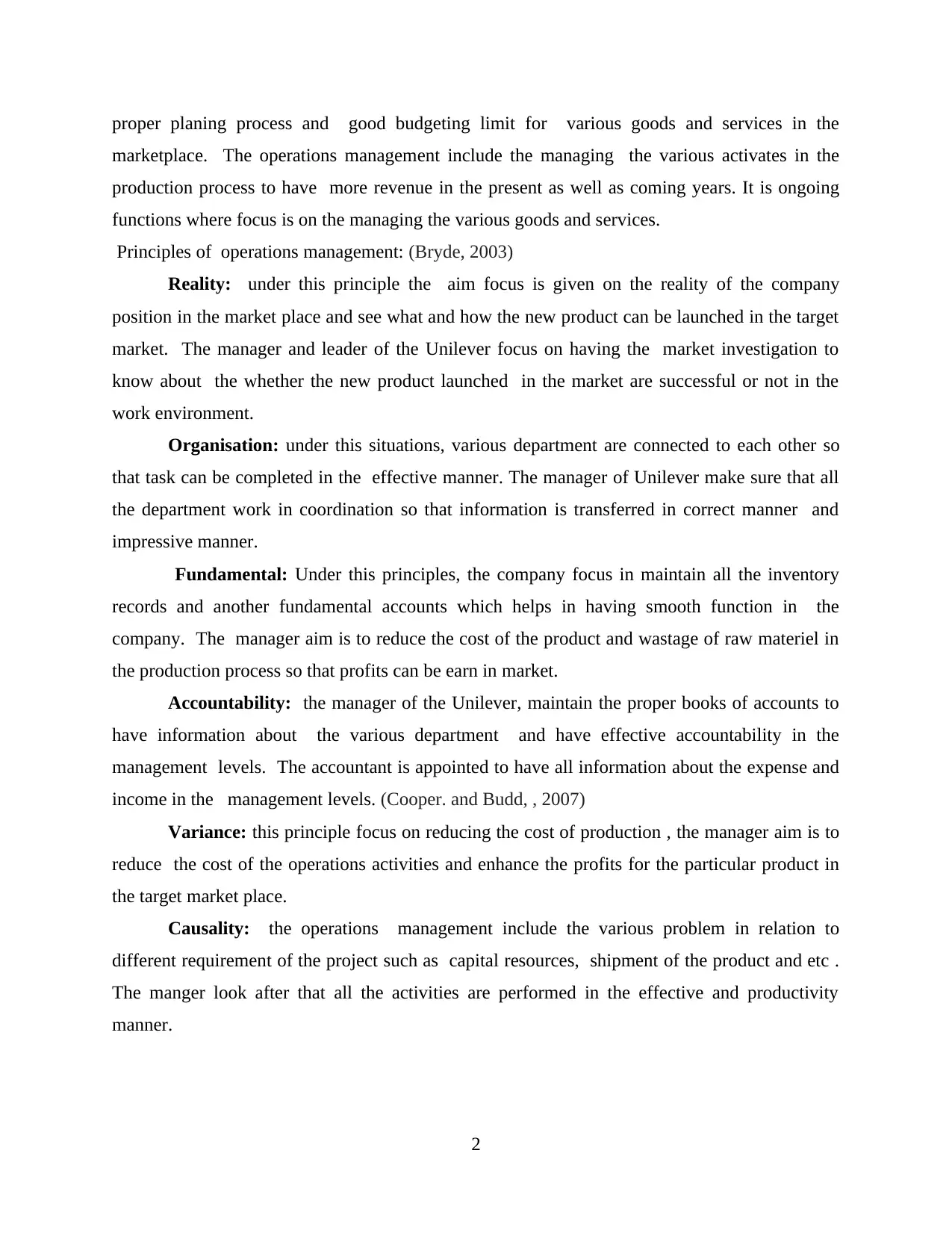
proper planing process and good budgeting limit for various goods and services in the
marketplace. The operations management include the managing the various activates in the
production process to have more revenue in the present as well as coming years. It is ongoing
functions where focus is on the managing the various goods and services.
Principles of operations management: (Bryde, 2003)
Reality: under this principle the aim focus is given on the reality of the company
position in the market place and see what and how the new product can be launched in the target
market. The manager and leader of the Unilever focus on having the market investigation to
know about the whether the new product launched in the market are successful or not in the
work environment.
Organisation: under this situations, various department are connected to each other so
that task can be completed in the effective manner. The manager of Unilever make sure that all
the department work in coordination so that information is transferred in correct manner and
impressive manner.
Fundamental: Under this principles, the company focus in maintain all the inventory
records and another fundamental accounts which helps in having smooth function in the
company. The manager aim is to reduce the cost of the product and wastage of raw materiel in
the production process so that profits can be earn in market.
Accountability: the manager of the Unilever, maintain the proper books of accounts to
have information about the various department and have effective accountability in the
management levels. The accountant is appointed to have all information about the expense and
income in the management levels. (Cooper. and Budd, , 2007)
Variance: this principle focus on reducing the cost of production , the manager aim is to
reduce the cost of the operations activities and enhance the profits for the particular product in
the target market place.
Causality: the operations management include the various problem in relation to
different requirement of the project such as capital resources, shipment of the product and etc .
The manger look after that all the activities are performed in the effective and productivity
manner.
2
marketplace. The operations management include the managing the various activates in the
production process to have more revenue in the present as well as coming years. It is ongoing
functions where focus is on the managing the various goods and services.
Principles of operations management: (Bryde, 2003)
Reality: under this principle the aim focus is given on the reality of the company
position in the market place and see what and how the new product can be launched in the target
market. The manager and leader of the Unilever focus on having the market investigation to
know about the whether the new product launched in the market are successful or not in the
work environment.
Organisation: under this situations, various department are connected to each other so
that task can be completed in the effective manner. The manager of Unilever make sure that all
the department work in coordination so that information is transferred in correct manner and
impressive manner.
Fundamental: Under this principles, the company focus in maintain all the inventory
records and another fundamental accounts which helps in having smooth function in the
company. The manager aim is to reduce the cost of the product and wastage of raw materiel in
the production process so that profits can be earn in market.
Accountability: the manager of the Unilever, maintain the proper books of accounts to
have information about the various department and have effective accountability in the
management levels. The accountant is appointed to have all information about the expense and
income in the management levels. (Cooper. and Budd, , 2007)
Variance: this principle focus on reducing the cost of production , the manager aim is to
reduce the cost of the operations activities and enhance the profits for the particular product in
the target market place.
Causality: the operations management include the various problem in relation to
different requirement of the project such as capital resources, shipment of the product and etc .
The manger look after that all the activities are performed in the effective and productivity
manner.
2
Paraphrase This Document
Need a fresh take? Get an instant paraphrase of this document with our AI Paraphraser
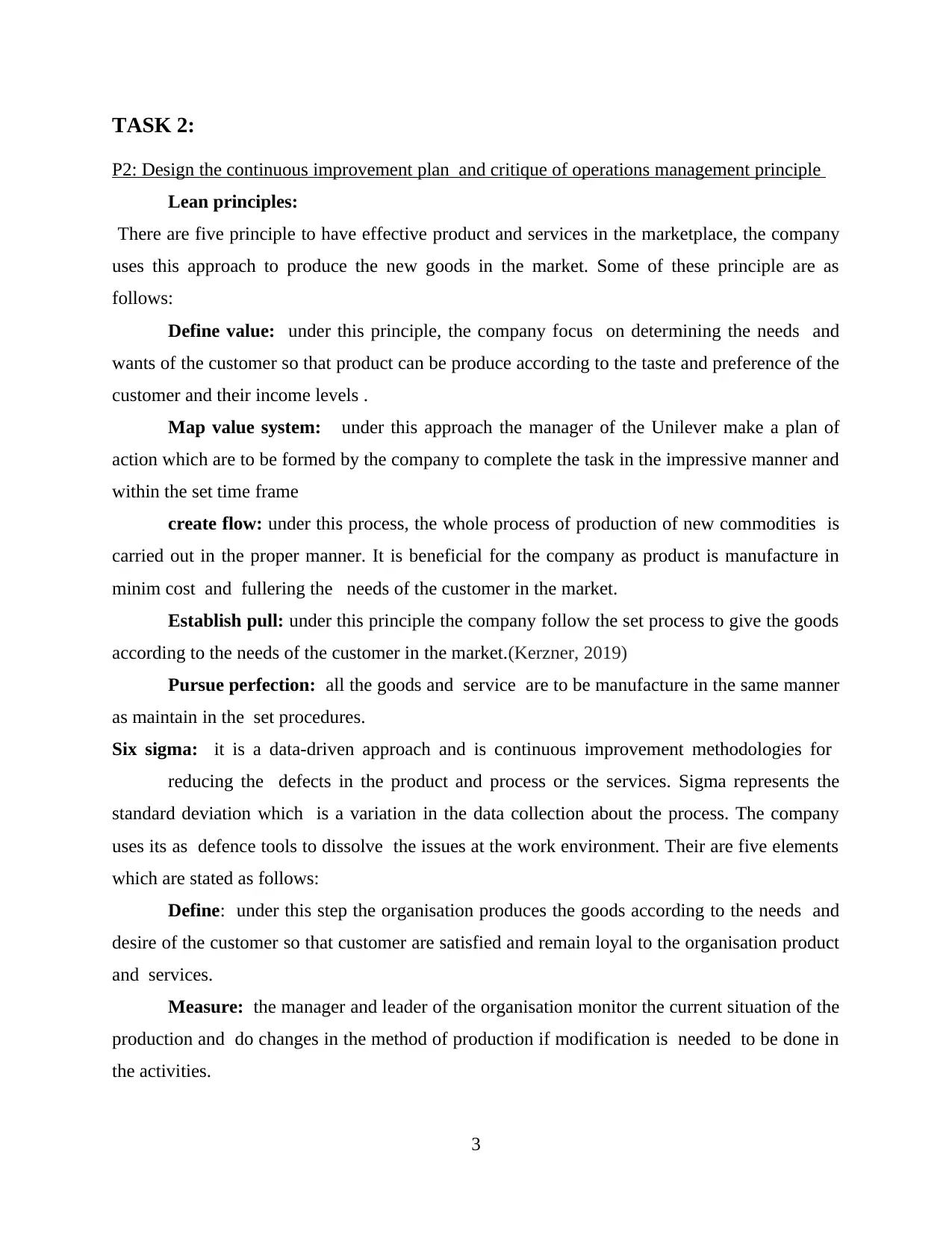
TASK 2:
P2: Design the continuous improvement plan and critique of operations management principle
Lean principles:
There are five principle to have effective product and services in the marketplace, the company
uses this approach to produce the new goods in the market. Some of these principle are as
follows:
Define value: under this principle, the company focus on determining the needs and
wants of the customer so that product can be produce according to the taste and preference of the
customer and their income levels .
Map value system: under this approach the manager of the Unilever make a plan of
action which are to be formed by the company to complete the task in the impressive manner and
within the set time frame
create flow: under this process, the whole process of production of new commodities is
carried out in the proper manner. It is beneficial for the company as product is manufacture in
minim cost and fullering the needs of the customer in the market.
Establish pull: under this principle the company follow the set process to give the goods
according to the needs of the customer in the market.(Kerzner, 2019)
Pursue perfection: all the goods and service are to be manufacture in the same manner
as maintain in the set procedures.
Six sigma: it is a data-driven approach and is continuous improvement methodologies for
reducing the defects in the product and process or the services. Sigma represents the
standard deviation which is a variation in the data collection about the process. The company
uses its as defence tools to dissolve the issues at the work environment. Their are five elements
which are stated as follows:
Define: under this step the organisation produces the goods according to the needs and
desire of the customer so that customer are satisfied and remain loyal to the organisation product
and services.
Measure: the manager and leader of the organisation monitor the current situation of the
production and do changes in the method of production if modification is needed to be done in
the activities.
3
P2: Design the continuous improvement plan and critique of operations management principle
Lean principles:
There are five principle to have effective product and services in the marketplace, the company
uses this approach to produce the new goods in the market. Some of these principle are as
follows:
Define value: under this principle, the company focus on determining the needs and
wants of the customer so that product can be produce according to the taste and preference of the
customer and their income levels .
Map value system: under this approach the manager of the Unilever make a plan of
action which are to be formed by the company to complete the task in the impressive manner and
within the set time frame
create flow: under this process, the whole process of production of new commodities is
carried out in the proper manner. It is beneficial for the company as product is manufacture in
minim cost and fullering the needs of the customer in the market.
Establish pull: under this principle the company follow the set process to give the goods
according to the needs of the customer in the market.(Kerzner, 2019)
Pursue perfection: all the goods and service are to be manufacture in the same manner
as maintain in the set procedures.
Six sigma: it is a data-driven approach and is continuous improvement methodologies for
reducing the defects in the product and process or the services. Sigma represents the
standard deviation which is a variation in the data collection about the process. The company
uses its as defence tools to dissolve the issues at the work environment. Their are five elements
which are stated as follows:
Define: under this step the organisation produces the goods according to the needs and
desire of the customer so that customer are satisfied and remain loyal to the organisation product
and services.
Measure: the manager and leader of the organisation monitor the current situation of the
production and do changes in the method of production if modification is needed to be done in
the activities.
3
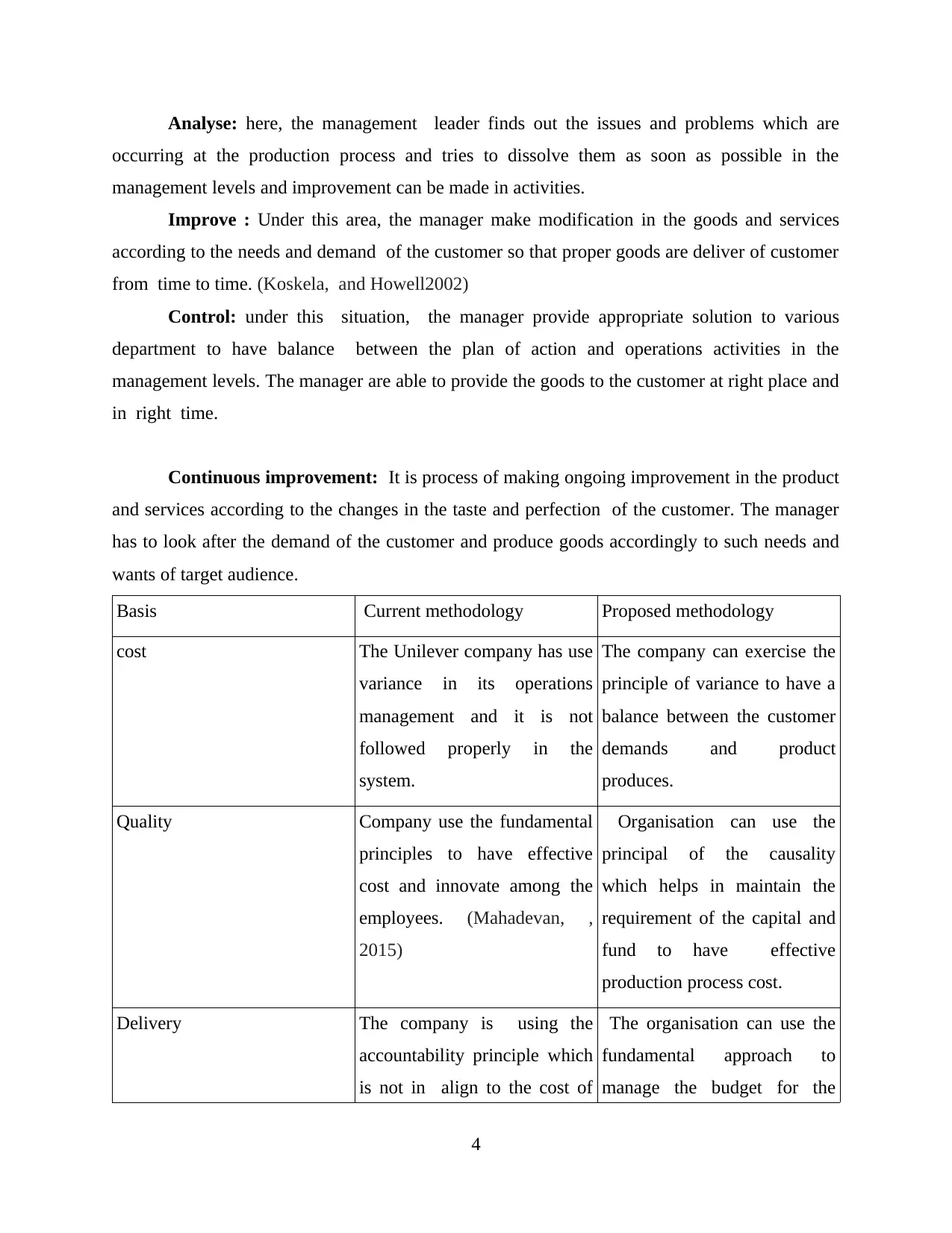
Analyse: here, the management leader finds out the issues and problems which are
occurring at the production process and tries to dissolve them as soon as possible in the
management levels and improvement can be made in activities.
Improve : Under this area, the manager make modification in the goods and services
according to the needs and demand of the customer so that proper goods are deliver of customer
from time to time. (Koskela, and Howell2002)
Control: under this situation, the manager provide appropriate solution to various
department to have balance between the plan of action and operations activities in the
management levels. The manager are able to provide the goods to the customer at right place and
in right time.
Continuous improvement: It is process of making ongoing improvement in the product
and services according to the changes in the taste and perfection of the customer. The manager
has to look after the demand of the customer and produce goods accordingly to such needs and
wants of target audience.
Basis Current methodology Proposed methodology
cost The Unilever company has use
variance in its operations
management and it is not
followed properly in the
system.
The company can exercise the
principle of variance to have a
balance between the customer
demands and product
produces.
Quality Company use the fundamental
principles to have effective
cost and innovate among the
employees. (Mahadevan, ,
2015)
Organisation can use the
principal of the causality
which helps in maintain the
requirement of the capital and
fund to have effective
production process cost.
Delivery The company is using the
accountability principle which
is not in align to the cost of
The organisation can use the
fundamental approach to
manage the budget for the
4
occurring at the production process and tries to dissolve them as soon as possible in the
management levels and improvement can be made in activities.
Improve : Under this area, the manager make modification in the goods and services
according to the needs and demand of the customer so that proper goods are deliver of customer
from time to time. (Koskela, and Howell2002)
Control: under this situation, the manager provide appropriate solution to various
department to have balance between the plan of action and operations activities in the
management levels. The manager are able to provide the goods to the customer at right place and
in right time.
Continuous improvement: It is process of making ongoing improvement in the product
and services according to the changes in the taste and perfection of the customer. The manager
has to look after the demand of the customer and produce goods accordingly to such needs and
wants of target audience.
Basis Current methodology Proposed methodology
cost The Unilever company has use
variance in its operations
management and it is not
followed properly in the
system.
The company can exercise the
principle of variance to have a
balance between the customer
demands and product
produces.
Quality Company use the fundamental
principles to have effective
cost and innovate among the
employees. (Mahadevan, ,
2015)
Organisation can use the
principal of the causality
which helps in maintain the
requirement of the capital and
fund to have effective
production process cost.
Delivery The company is using the
accountability principle which
is not in align to the cost of
The organisation can use the
fundamental approach to
manage the budget for the
4
⊘ This is a preview!⊘
Do you want full access?
Subscribe today to unlock all pages.

Trusted by 1+ million students worldwide
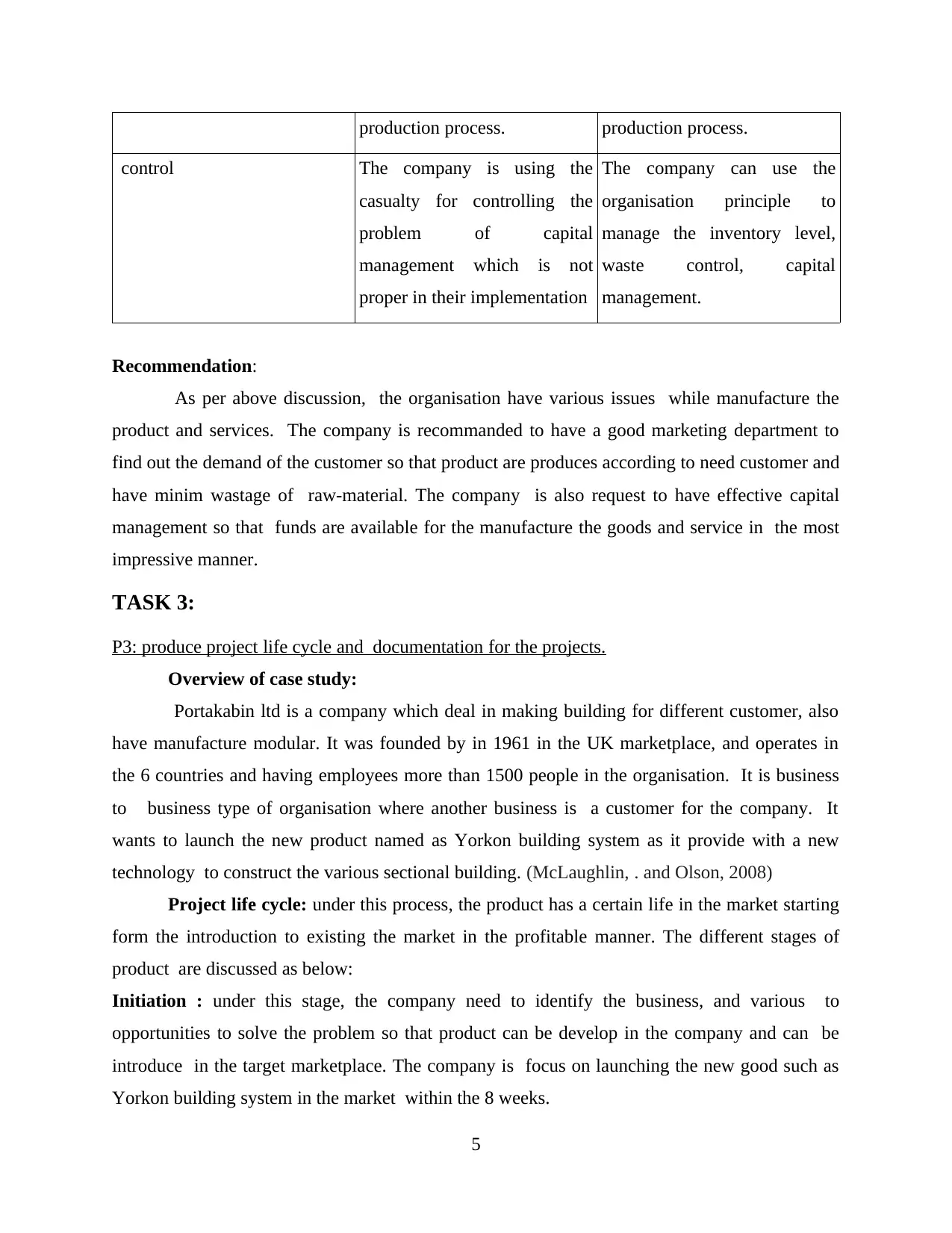
production process. production process.
control The company is using the
casualty for controlling the
problem of capital
management which is not
proper in their implementation
The company can use the
organisation principle to
manage the inventory level,
waste control, capital
management.
Recommendation:
As per above discussion, the organisation have various issues while manufacture the
product and services. The company is recommanded to have a good marketing department to
find out the demand of the customer so that product are produces according to need customer and
have minim wastage of raw-material. The company is also request to have effective capital
management so that funds are available for the manufacture the goods and service in the most
impressive manner.
TASK 3:
P3: produce project life cycle and documentation for the projects.
Overview of case study:
Portakabin ltd is a company which deal in making building for different customer, also
have manufacture modular. It was founded by in 1961 in the UK marketplace, and operates in
the 6 countries and having employees more than 1500 people in the organisation. It is business
to business type of organisation where another business is a customer for the company. It
wants to launch the new product named as Yorkon building system as it provide with a new
technology to construct the various sectional building. (McLaughlin, . and Olson, 2008)
Project life cycle: under this process, the product has a certain life in the market starting
form the introduction to existing the market in the profitable manner. The different stages of
product are discussed as below:
Initiation : under this stage, the company need to identify the business, and various to
opportunities to solve the problem so that product can be develop in the company and can be
introduce in the target marketplace. The company is focus on launching the new good such as
Yorkon building system in the market within the 8 weeks.
5
control The company is using the
casualty for controlling the
problem of capital
management which is not
proper in their implementation
The company can use the
organisation principle to
manage the inventory level,
waste control, capital
management.
Recommendation:
As per above discussion, the organisation have various issues while manufacture the
product and services. The company is recommanded to have a good marketing department to
find out the demand of the customer so that product are produces according to need customer and
have minim wastage of raw-material. The company is also request to have effective capital
management so that funds are available for the manufacture the goods and service in the most
impressive manner.
TASK 3:
P3: produce project life cycle and documentation for the projects.
Overview of case study:
Portakabin ltd is a company which deal in making building for different customer, also
have manufacture modular. It was founded by in 1961 in the UK marketplace, and operates in
the 6 countries and having employees more than 1500 people in the organisation. It is business
to business type of organisation where another business is a customer for the company. It
wants to launch the new product named as Yorkon building system as it provide with a new
technology to construct the various sectional building. (McLaughlin, . and Olson, 2008)
Project life cycle: under this process, the product has a certain life in the market starting
form the introduction to existing the market in the profitable manner. The different stages of
product are discussed as below:
Initiation : under this stage, the company need to identify the business, and various to
opportunities to solve the problem so that product can be develop in the company and can be
introduce in the target marketplace. The company is focus on launching the new good such as
Yorkon building system in the market within the 8 weeks.
5
Paraphrase This Document
Need a fresh take? Get an instant paraphrase of this document with our AI Paraphraser
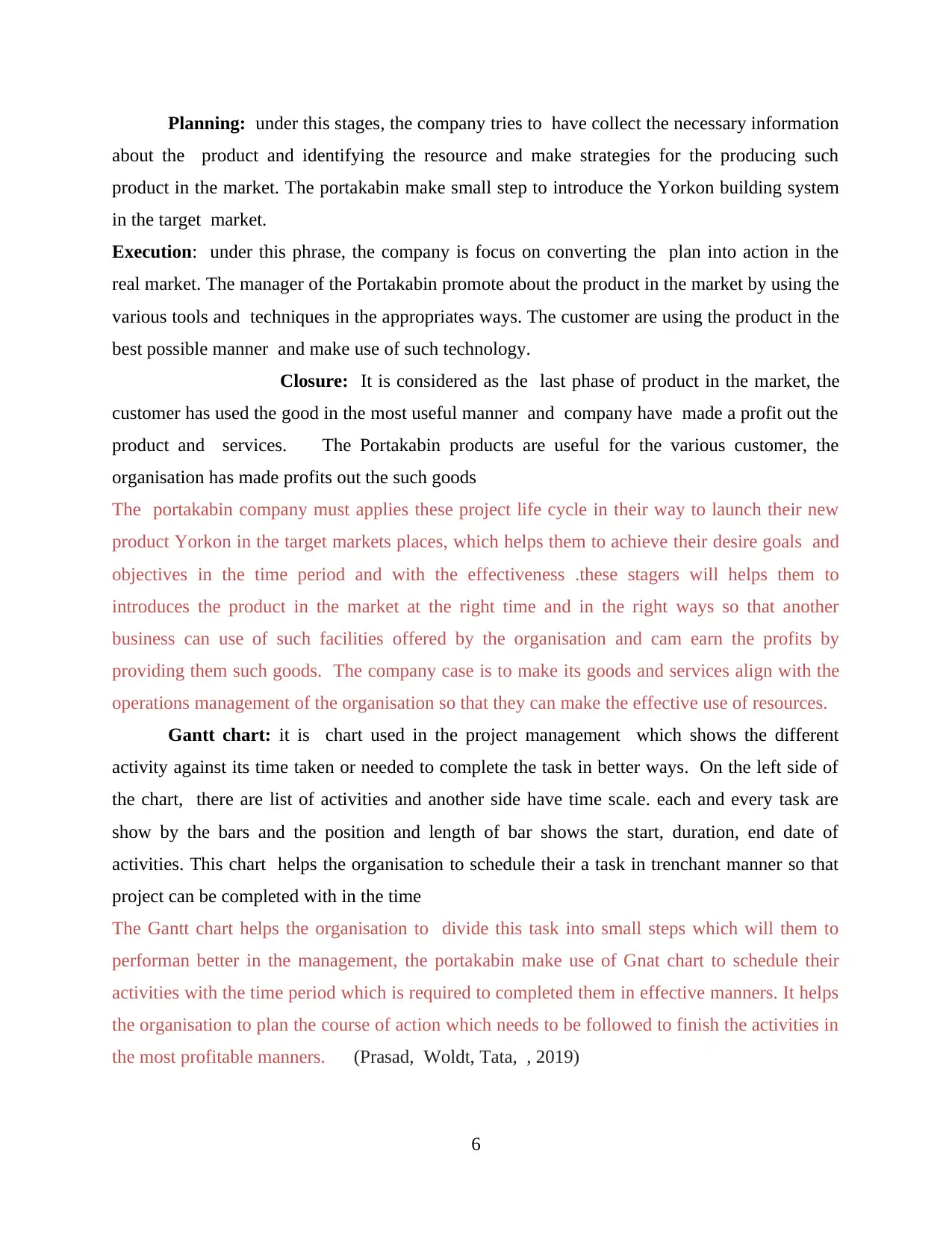
Planning: under this stages, the company tries to have collect the necessary information
about the product and identifying the resource and make strategies for the producing such
product in the market. The portakabin make small step to introduce the Yorkon building system
in the target market.
Execution: under this phrase, the company is focus on converting the plan into action in the
real market. The manager of the Portakabin promote about the product in the market by using the
various tools and techniques in the appropriates ways. The customer are using the product in the
best possible manner and make use of such technology.
Closure: It is considered as the last phase of product in the market, the
customer has used the good in the most useful manner and company have made a profit out the
product and services. The Portakabin products are useful for the various customer, the
organisation has made profits out the such goods
The portakabin company must applies these project life cycle in their way to launch their new
product Yorkon in the target markets places, which helps them to achieve their desire goals and
objectives in the time period and with the effectiveness .these stagers will helps them to
introduces the product in the market at the right time and in the right ways so that another
business can use of such facilities offered by the organisation and cam earn the profits by
providing them such goods. The company case is to make its goods and services align with the
operations management of the organisation so that they can make the effective use of resources.
Gantt chart: it is chart used in the project management which shows the different
activity against its time taken or needed to complete the task in better ways. On the left side of
the chart, there are list of activities and another side have time scale. each and every task are
show by the bars and the position and length of bar shows the start, duration, end date of
activities. This chart helps the organisation to schedule their a task in trenchant manner so that
project can be completed with in the time
The Gantt chart helps the organisation to divide this task into small steps which will them to
performan better in the management, the portakabin make use of Gnat chart to schedule their
activities with the time period which is required to completed them in effective manners. It helps
the organisation to plan the course of action which needs to be followed to finish the activities in
the most profitable manners. (Prasad, Woldt, Tata, , 2019)
6
about the product and identifying the resource and make strategies for the producing such
product in the market. The portakabin make small step to introduce the Yorkon building system
in the target market.
Execution: under this phrase, the company is focus on converting the plan into action in the
real market. The manager of the Portakabin promote about the product in the market by using the
various tools and techniques in the appropriates ways. The customer are using the product in the
best possible manner and make use of such technology.
Closure: It is considered as the last phase of product in the market, the
customer has used the good in the most useful manner and company have made a profit out the
product and services. The Portakabin products are useful for the various customer, the
organisation has made profits out the such goods
The portakabin company must applies these project life cycle in their way to launch their new
product Yorkon in the target markets places, which helps them to achieve their desire goals and
objectives in the time period and with the effectiveness .these stagers will helps them to
introduces the product in the market at the right time and in the right ways so that another
business can use of such facilities offered by the organisation and cam earn the profits by
providing them such goods. The company case is to make its goods and services align with the
operations management of the organisation so that they can make the effective use of resources.
Gantt chart: it is chart used in the project management which shows the different
activity against its time taken or needed to complete the task in better ways. On the left side of
the chart, there are list of activities and another side have time scale. each and every task are
show by the bars and the position and length of bar shows the start, duration, end date of
activities. This chart helps the organisation to schedule their a task in trenchant manner so that
project can be completed with in the time
The Gantt chart helps the organisation to divide this task into small steps which will them to
performan better in the management, the portakabin make use of Gnat chart to schedule their
activities with the time period which is required to completed them in effective manners. It helps
the organisation to plan the course of action which needs to be followed to finish the activities in
the most profitable manners. (Prasad, Woldt, Tata, , 2019)
6
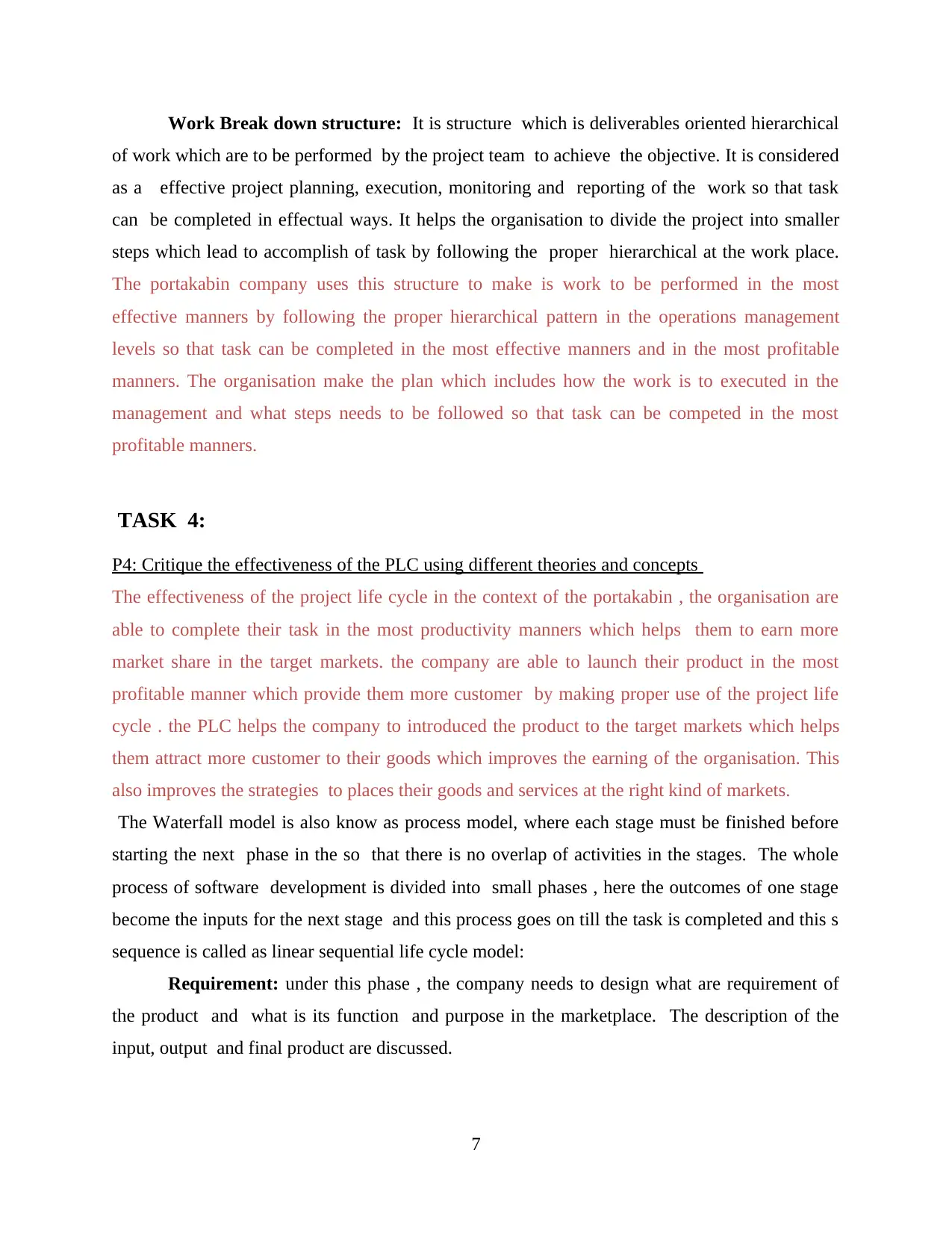
Work Break down structure: It is structure which is deliverables oriented hierarchical
of work which are to be performed by the project team to achieve the objective. It is considered
as a effective project planning, execution, monitoring and reporting of the work so that task
can be completed in effectual ways. It helps the organisation to divide the project into smaller
steps which lead to accomplish of task by following the proper hierarchical at the work place.
The portakabin company uses this structure to make is work to be performed in the most
effective manners by following the proper hierarchical pattern in the operations management
levels so that task can be completed in the most effective manners and in the most profitable
manners. The organisation make the plan which includes how the work is to executed in the
management and what steps needs to be followed so that task can be competed in the most
profitable manners.
TASK 4:
P4: Critique the effectiveness of the PLC using different theories and concepts
The effectiveness of the project life cycle in the context of the portakabin , the organisation are
able to complete their task in the most productivity manners which helps them to earn more
market share in the target markets. the company are able to launch their product in the most
profitable manner which provide them more customer by making proper use of the project life
cycle . the PLC helps the company to introduced the product to the target markets which helps
them attract more customer to their goods which improves the earning of the organisation. This
also improves the strategies to places their goods and services at the right kind of markets.
The Waterfall model is also know as process model, where each stage must be finished before
starting the next phase in the so that there is no overlap of activities in the stages. The whole
process of software development is divided into small phases , here the outcomes of one stage
become the inputs for the next stage and this process goes on till the task is completed and this s
sequence is called as linear sequential life cycle model:
Requirement: under this phase , the company needs to design what are requirement of
the product and what is its function and purpose in the marketplace. The description of the
input, output and final product are discussed.
7
of work which are to be performed by the project team to achieve the objective. It is considered
as a effective project planning, execution, monitoring and reporting of the work so that task
can be completed in effectual ways. It helps the organisation to divide the project into smaller
steps which lead to accomplish of task by following the proper hierarchical at the work place.
The portakabin company uses this structure to make is work to be performed in the most
effective manners by following the proper hierarchical pattern in the operations management
levels so that task can be completed in the most effective manners and in the most profitable
manners. The organisation make the plan which includes how the work is to executed in the
management and what steps needs to be followed so that task can be competed in the most
profitable manners.
TASK 4:
P4: Critique the effectiveness of the PLC using different theories and concepts
The effectiveness of the project life cycle in the context of the portakabin , the organisation are
able to complete their task in the most productivity manners which helps them to earn more
market share in the target markets. the company are able to launch their product in the most
profitable manner which provide them more customer by making proper use of the project life
cycle . the PLC helps the company to introduced the product to the target markets which helps
them attract more customer to their goods which improves the earning of the organisation. This
also improves the strategies to places their goods and services at the right kind of markets.
The Waterfall model is also know as process model, where each stage must be finished before
starting the next phase in the so that there is no overlap of activities in the stages. The whole
process of software development is divided into small phases , here the outcomes of one stage
become the inputs for the next stage and this process goes on till the task is completed and this s
sequence is called as linear sequential life cycle model:
Requirement: under this phase , the company needs to design what are requirement of
the product and what is its function and purpose in the marketplace. The description of the
input, output and final product are discussed.
7
⊘ This is a preview!⊘
Do you want full access?
Subscribe today to unlock all pages.

Trusted by 1+ million students worldwide
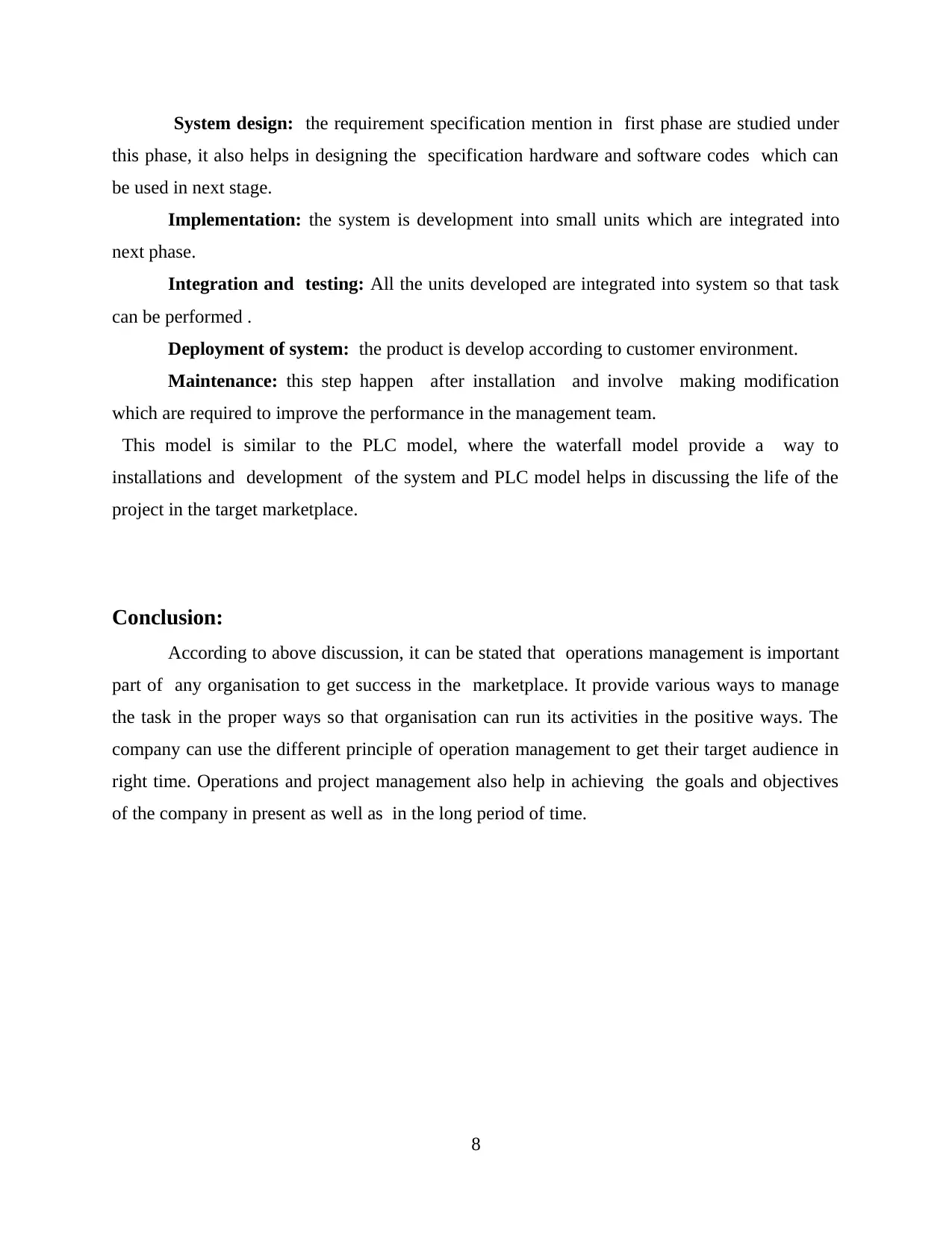
System design: the requirement specification mention in first phase are studied under
this phase, it also helps in designing the specification hardware and software codes which can
be used in next stage.
Implementation: the system is development into small units which are integrated into
next phase.
Integration and testing: All the units developed are integrated into system so that task
can be performed .
Deployment of system: the product is develop according to customer environment.
Maintenance: this step happen after installation and involve making modification
which are required to improve the performance in the management team.
This model is similar to the PLC model, where the waterfall model provide a way to
installations and development of the system and PLC model helps in discussing the life of the
project in the target marketplace.
Conclusion:
According to above discussion, it can be stated that operations management is important
part of any organisation to get success in the marketplace. It provide various ways to manage
the task in the proper ways so that organisation can run its activities in the positive ways. The
company can use the different principle of operation management to get their target audience in
right time. Operations and project management also help in achieving the goals and objectives
of the company in present as well as in the long period of time.
8
this phase, it also helps in designing the specification hardware and software codes which can
be used in next stage.
Implementation: the system is development into small units which are integrated into
next phase.
Integration and testing: All the units developed are integrated into system so that task
can be performed .
Deployment of system: the product is develop according to customer environment.
Maintenance: this step happen after installation and involve making modification
which are required to improve the performance in the management team.
This model is similar to the PLC model, where the waterfall model provide a way to
installations and development of the system and PLC model helps in discussing the life of the
project in the target marketplace.
Conclusion:
According to above discussion, it can be stated that operations management is important
part of any organisation to get success in the marketplace. It provide various ways to manage
the task in the proper ways so that organisation can run its activities in the positive ways. The
company can use the different principle of operation management to get their target audience in
right time. Operations and project management also help in achieving the goals and objectives
of the company in present as well as in the long period of time.
8
Paraphrase This Document
Need a fresh take? Get an instant paraphrase of this document with our AI Paraphraser
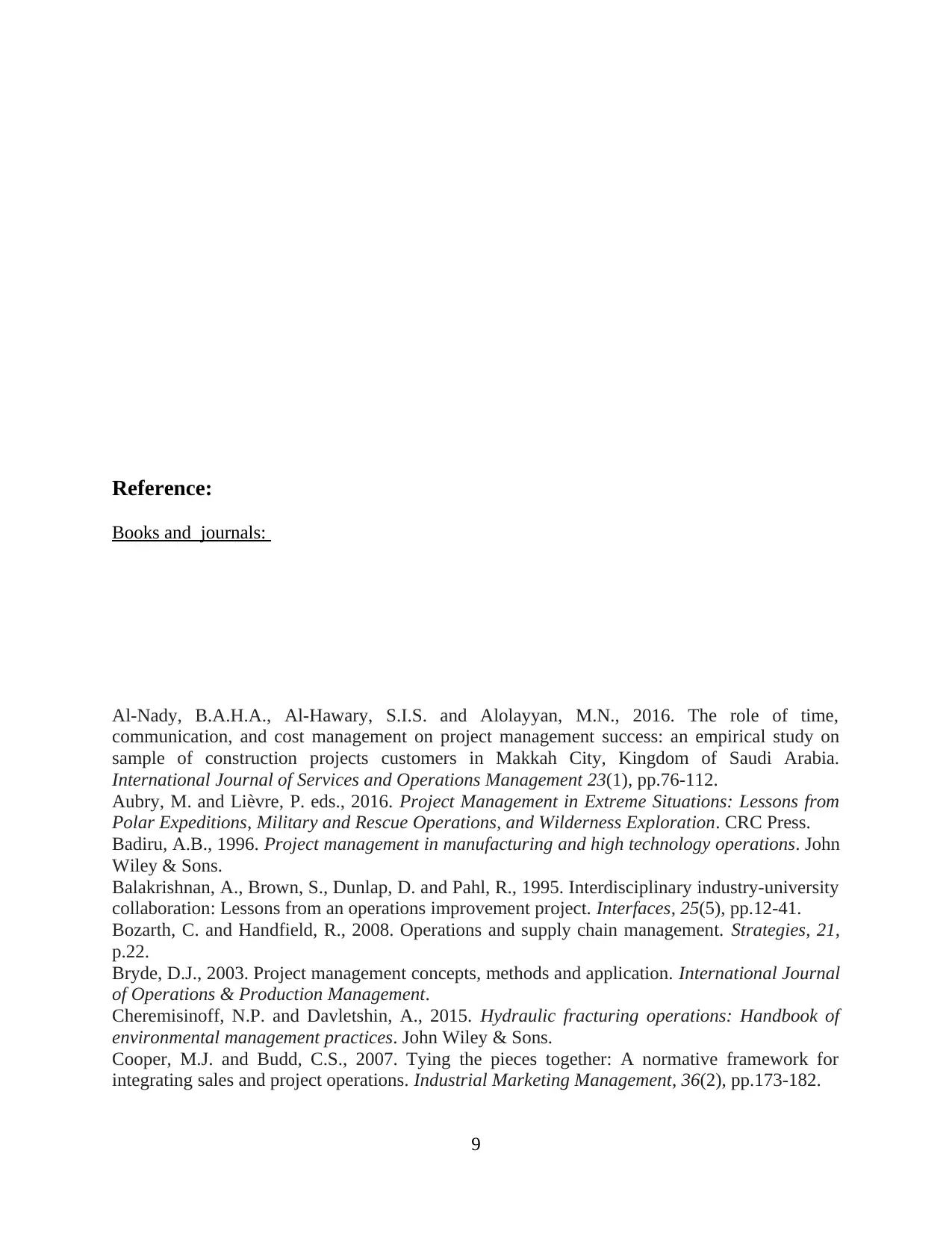
Reference:
Books and journals:
Al-Nady, B.A.H.A., Al-Hawary, S.I.S. and Alolayyan, M.N., 2016. The role of time,
communication, and cost management on project management success: an empirical study on
sample of construction projects customers in Makkah City, Kingdom of Saudi Arabia.
International Journal of Services and Operations Management 23(1), pp.76-112.
Aubry, M. and Lièvre, P. eds., 2016. Project Management in Extreme Situations: Lessons from
Polar Expeditions, Military and Rescue Operations, and Wilderness Exploration. CRC Press.
Badiru, A.B., 1996. Project management in manufacturing and high technology operations. John
Wiley & Sons.
Balakrishnan, A., Brown, S., Dunlap, D. and Pahl, R., 1995. Interdisciplinary industry-university
collaboration: Lessons from an operations improvement project. Interfaces, 25(5), pp.12-41.
Bozarth, C. and Handfield, R., 2008. Operations and supply chain management. Strategies, 21,
p.22.
Bryde, D.J., 2003. Project management concepts, methods and application. International Journal
of Operations & Production Management.
Cheremisinoff, N.P. and Davletshin, A., 2015. Hydraulic fracturing operations: Handbook of
environmental management practices. John Wiley & Sons.
Cooper, M.J. and Budd, C.S., 2007. Tying the pieces together: A normative framework for
integrating sales and project operations. Industrial Marketing Management, 36(2), pp.173-182.
9
Books and journals:
Al-Nady, B.A.H.A., Al-Hawary, S.I.S. and Alolayyan, M.N., 2016. The role of time,
communication, and cost management on project management success: an empirical study on
sample of construction projects customers in Makkah City, Kingdom of Saudi Arabia.
International Journal of Services and Operations Management 23(1), pp.76-112.
Aubry, M. and Lièvre, P. eds., 2016. Project Management in Extreme Situations: Lessons from
Polar Expeditions, Military and Rescue Operations, and Wilderness Exploration. CRC Press.
Badiru, A.B., 1996. Project management in manufacturing and high technology operations. John
Wiley & Sons.
Balakrishnan, A., Brown, S., Dunlap, D. and Pahl, R., 1995. Interdisciplinary industry-university
collaboration: Lessons from an operations improvement project. Interfaces, 25(5), pp.12-41.
Bozarth, C. and Handfield, R., 2008. Operations and supply chain management. Strategies, 21,
p.22.
Bryde, D.J., 2003. Project management concepts, methods and application. International Journal
of Operations & Production Management.
Cheremisinoff, N.P. and Davletshin, A., 2015. Hydraulic fracturing operations: Handbook of
environmental management practices. John Wiley & Sons.
Cooper, M.J. and Budd, C.S., 2007. Tying the pieces together: A normative framework for
integrating sales and project operations. Industrial Marketing Management, 36(2), pp.173-182.
9
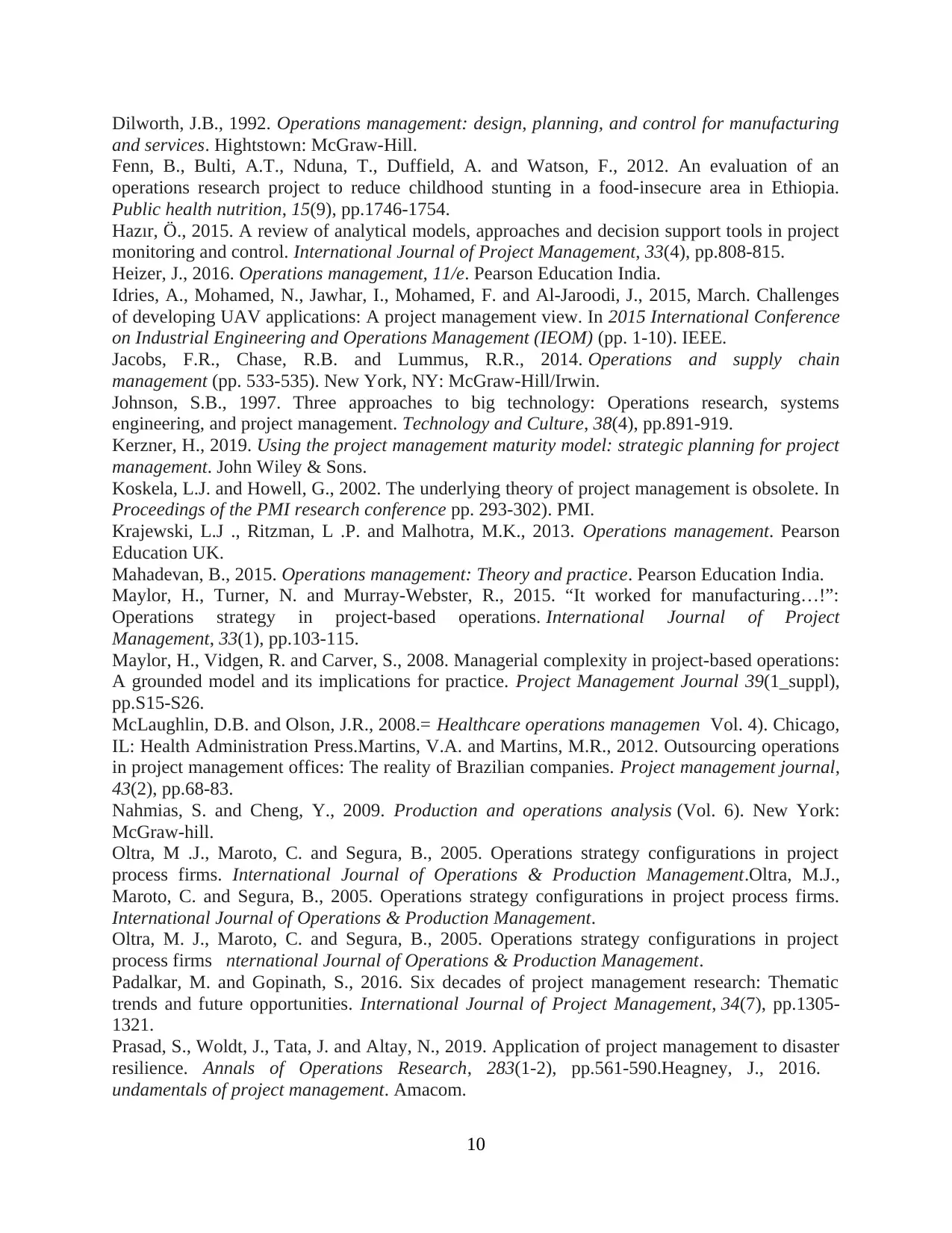
Dilworth, J.B., 1992. Operations management: design, planning, and control for manufacturing
and services. Hightstown: McGraw-Hill.
Fenn, B., Bulti, A.T., Nduna, T., Duffield, A. and Watson, F., 2012. An evaluation of an
operations research project to reduce childhood stunting in a food-insecure area in Ethiopia.
Public health nutrition, 15(9), pp.1746-1754.
Hazır, Ö., 2015. A review of analytical models, approaches and decision support tools in project
monitoring and control. International Journal of Project Management, 33(4), pp.808-815.
Heizer, J., 2016. Operations management, 11/e. Pearson Education India.
Idries, A., Mohamed, N., Jawhar, I., Mohamed, F. and Al-Jaroodi, J., 2015, March. Challenges
of developing UAV applications: A project management view. In 2015 International Conference
on Industrial Engineering and Operations Management (IEOM) (pp. 1-10). IEEE.
Jacobs, F.R., Chase, R.B. and Lummus, R.R., 2014. Operations and supply chain
management (pp. 533-535). New York, NY: McGraw-Hill/Irwin.
Johnson, S.B., 1997. Three approaches to big technology: Operations research, systems
engineering, and project management. Technology and Culture, 38(4), pp.891-919.
Kerzner, H., 2019. Using the project management maturity model: strategic planning for project
management. John Wiley & Sons.
Koskela, L.J. and Howell, G., 2002. The underlying theory of project management is obsolete. In
Proceedings of the PMI research conference pp. 293-302). PMI.
Krajewski, L.J ., Ritzman, L .P. and Malhotra, M.K., 2013. Operations management. Pearson
Education UK.
Mahadevan, B., 2015. Operations management: Theory and practice. Pearson Education India.
Maylor, H., Turner, N. and Murray-Webster, R., 2015. “It worked for manufacturing…!”:
Operations strategy in project-based operations. International Journal of Project
Management, 33(1), pp.103-115.
Maylor, H., Vidgen, R. and Carver, S., 2008. Managerial complexity in project-based operations:
A grounded model and its implications for practice. Project Management Journal 39(1_suppl),
pp.S15-S26.
McLaughlin, D.B. and Olson, J.R., 2008.= Healthcare operations managemen Vol. 4). Chicago,
IL: Health Administration Press.Martins, V.A. and Martins, M.R., 2012. Outsourcing operations
in project management offices: The reality of Brazilian companies. Project management journal,
43(2), pp.68-83.
Nahmias, S. and Cheng, Y., 2009. Production and operations analysis (Vol. 6). New York:
McGraw-hill.
Oltra, M .J., Maroto, C. and Segura, B., 2005. Operations strategy configurations in project
process firms. International Journal of Operations & Production Management.Oltra, M.J.,
Maroto, C. and Segura, B., 2005. Operations strategy configurations in project process firms.
International Journal of Operations & Production Management.
Oltra, M. J., Maroto, C. and Segura, B., 2005. Operations strategy configurations in project
process firms nternational Journal of Operations & Production Management.
Padalkar, M. and Gopinath, S., 2016. Six decades of project management research: Thematic
trends and future opportunities. International Journal of Project Management, 34(7), pp.1305-
1321.
Prasad, S., Woldt, J., Tata, J. and Altay, N., 2019. Application of project management to disaster
resilience. Annals of Operations Research, 283(1-2), pp.561-590.Heagney, J., 2016.
undamentals of project management. Amacom.
10
and services. Hightstown: McGraw-Hill.
Fenn, B., Bulti, A.T., Nduna, T., Duffield, A. and Watson, F., 2012. An evaluation of an
operations research project to reduce childhood stunting in a food-insecure area in Ethiopia.
Public health nutrition, 15(9), pp.1746-1754.
Hazır, Ö., 2015. A review of analytical models, approaches and decision support tools in project
monitoring and control. International Journal of Project Management, 33(4), pp.808-815.
Heizer, J., 2016. Operations management, 11/e. Pearson Education India.
Idries, A., Mohamed, N., Jawhar, I., Mohamed, F. and Al-Jaroodi, J., 2015, March. Challenges
of developing UAV applications: A project management view. In 2015 International Conference
on Industrial Engineering and Operations Management (IEOM) (pp. 1-10). IEEE.
Jacobs, F.R., Chase, R.B. and Lummus, R.R., 2014. Operations and supply chain
management (pp. 533-535). New York, NY: McGraw-Hill/Irwin.
Johnson, S.B., 1997. Three approaches to big technology: Operations research, systems
engineering, and project management. Technology and Culture, 38(4), pp.891-919.
Kerzner, H., 2019. Using the project management maturity model: strategic planning for project
management. John Wiley & Sons.
Koskela, L.J. and Howell, G., 2002. The underlying theory of project management is obsolete. In
Proceedings of the PMI research conference pp. 293-302). PMI.
Krajewski, L.J ., Ritzman, L .P. and Malhotra, M.K., 2013. Operations management. Pearson
Education UK.
Mahadevan, B., 2015. Operations management: Theory and practice. Pearson Education India.
Maylor, H., Turner, N. and Murray-Webster, R., 2015. “It worked for manufacturing…!”:
Operations strategy in project-based operations. International Journal of Project
Management, 33(1), pp.103-115.
Maylor, H., Vidgen, R. and Carver, S., 2008. Managerial complexity in project-based operations:
A grounded model and its implications for practice. Project Management Journal 39(1_suppl),
pp.S15-S26.
McLaughlin, D.B. and Olson, J.R., 2008.= Healthcare operations managemen Vol. 4). Chicago,
IL: Health Administration Press.Martins, V.A. and Martins, M.R., 2012. Outsourcing operations
in project management offices: The reality of Brazilian companies. Project management journal,
43(2), pp.68-83.
Nahmias, S. and Cheng, Y., 2009. Production and operations analysis (Vol. 6). New York:
McGraw-hill.
Oltra, M .J., Maroto, C. and Segura, B., 2005. Operations strategy configurations in project
process firms. International Journal of Operations & Production Management.Oltra, M.J.,
Maroto, C. and Segura, B., 2005. Operations strategy configurations in project process firms.
International Journal of Operations & Production Management.
Oltra, M. J., Maroto, C. and Segura, B., 2005. Operations strategy configurations in project
process firms nternational Journal of Operations & Production Management.
Padalkar, M. and Gopinath, S., 2016. Six decades of project management research: Thematic
trends and future opportunities. International Journal of Project Management, 34(7), pp.1305-
1321.
Prasad, S., Woldt, J., Tata, J. and Altay, N., 2019. Application of project management to disaster
resilience. Annals of Operations Research, 283(1-2), pp.561-590.Heagney, J., 2016.
undamentals of project management. Amacom.
10
⊘ This is a preview!⊘
Do you want full access?
Subscribe today to unlock all pages.

Trusted by 1+ million students worldwide
1 out of 13
Related Documents
Your All-in-One AI-Powered Toolkit for Academic Success.
+13062052269
info@desklib.com
Available 24*7 on WhatsApp / Email
![[object Object]](/_next/static/media/star-bottom.7253800d.svg)
Unlock your academic potential
Copyright © 2020–2025 A2Z Services. All Rights Reserved. Developed and managed by ZUCOL.





